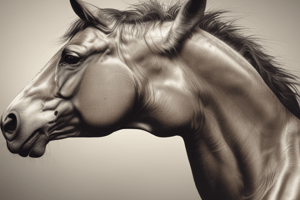Podcast
Questions and Answers
Which of the following is NOT a function of hair/fur?
Which of the following is NOT a function of hair/fur?
- Camouflage
- Thermoregulation
- Communication
- Protection (correct)
Which type of gland is responsible for producing sebum?
Which type of gland is responsible for producing sebum?
- Sebaceous gland (correct)
- Apocrine gland
- Sweat gland
- Eccrine gland
Where are sweat glands typically found in most domestic species?
Where are sweat glands typically found in most domestic species?
- Foot pads and deep layers of fat (correct)
- Hair follicles
- Dermis
- Nasal planum
What is the function of tail glands in dogs and cats?
What is the function of tail glands in dogs and cats?
Which of the following is NOT a characteristic of claws and hooves?
Which of the following is NOT a characteristic of claws and hooves?
What is the primary difference between horns and antlers?
What is the primary difference between horns and antlers?
What is the function of anal sacs?
What is the function of anal sacs?
Which phase of the hair growth cycle is the resting phase?
Which phase of the hair growth cycle is the resting phase?
What is the composition of sebum?
What is the composition of sebum?
What is the function of cutaneous pouches in sheep?
What is the function of cutaneous pouches in sheep?
Which layer of the skin is primarily composed of dead cells?
Which layer of the skin is primarily composed of dead cells?
What is the function of keratinization?
What is the function of keratinization?
Which cells produce melanin, a dark brown-black pigment?
Which cells produce melanin, a dark brown-black pigment?
Which layer of the epidermis is responsible for keratinization?
Which layer of the epidermis is responsible for keratinization?
What is the largest part of the skin that provides structural strength?
What is the largest part of the skin that provides structural strength?
Which layer of the dermis is just beneath the epidermis?
Which layer of the dermis is just beneath the epidermis?
What type of tissue is the reticular layer of the dermis composed of?
What type of tissue is the reticular layer of the dermis composed of?
Which special feature of the integument is composed of all five epidermal layers?
Which special feature of the integument is composed of all five epidermal layers?
What is the top of the nose called in dogs, cats, pigs, sheep, and goats?
What is the top of the nose called in dogs, cats, pigs, sheep, and goats?
What are the dark brown, horny patches on the legs of horses and other equid species called?
What are the dark brown, horny patches on the legs of horses and other equid species called?
Flashcards are hidden until you start studying
Study Notes
Hair/Fur Functions
- Insulation, protection, sensory input, and camouflage are primary functions of hair/fur.
- Not providing oxygen transfer is a function hair/fur does not perform.
Sebum Production
- Sebaceous glands are responsible for producing sebum, which helps in lubricating the skin and fur.
Sweat Gland Locations
- Sweat glands are typically found in areas such as paw pads and between toes in most domestic species.
Tail Glands
- Tail glands in dogs and cats function in communication through scent marking and signaling social status.
Claws and Hooves Characteristics
- Claws and hooves do not possess the same structure and function as nails found in other species.
Horns vs. Antlers
- The primary difference is that horns are permanent and typically unbranched, while antlers are bony, branched, and shed annually.
Anal Sacs Function
- Anal sacs function to produce a strong scent used for marking territory and communication.
Hair Growth Cycle
- The resting phase of the hair growth cycle is known as the telogen phase.
Composition of Sebum
- Sebum is composed primarily of lipids, including triglycerides, fatty acids, wax esters, and squalene.
Cutaneous Pouches in Sheep
- The function of cutaneous pouches in sheep includes secretion of oils that may help in protection and communication.
Epidermis Composition
- The outermost layer of the skin, mainly comprising dead cells, is the stratum corneum.
Keratinization Function
- Keratinization is essential for forming a protective barrier against environmental damage and water loss.
Melanin Production
- Melanocytes are the cells responsible for producing melanin, contributing to the color of skin, fur, and eyes.
Keratinization Layer
- The stratum granulosum layer of the epidermis is responsible for keratinization.
Skin's Structural Strength
- The dermis, particularly the reticular layer, is the largest part of the skin that provides structural strength.
Dermis Layers
- The papillary layer is the layer of the dermis just beneath the epidermis.
Reticular Layer Tissue Type
- The reticular layer of the dermis is composed of dense irregular connective tissue.
Integument Special Feature
- A special feature of the integument that comprises all five epidermal layers is the hoof.
Nose Top in Animals
- The top of the nose is referred to as the "planum" in dogs, cats, pigs, sheep, and goats.
Dark Brown Horny Patches
- The dark brown, horny patches on the legs of horses and other equids are known as "chestnuts."
Studying That Suits You
Use AI to generate personalized quizzes and flashcards to suit your learning preferences.




